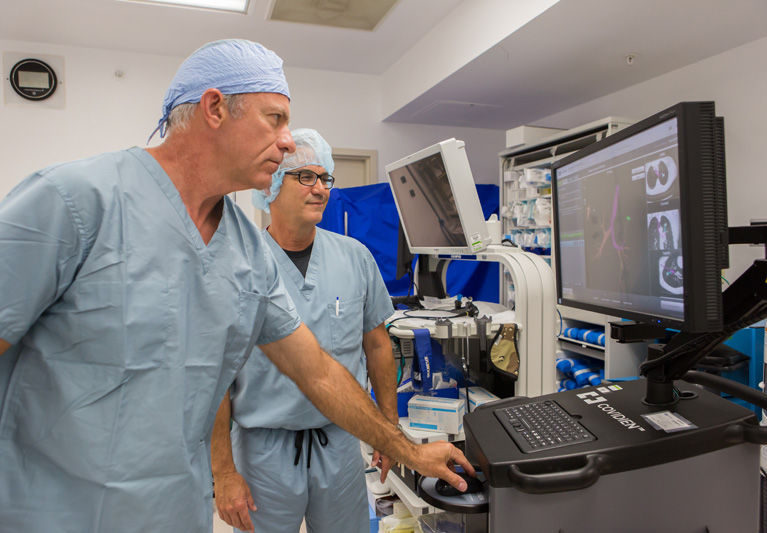
It isn’t often that any investment – even a six-figure one – yields a life-changing return in just a matter of days, but that’s exactly what just happened at the Sebastian River Medical Center.
The packing materials on the hospital’s newly delivered electromagnetic navigational bronchoscopy or ENB equipment had barely been cleared away when Dr. Michael Green of Treasure Coast Thoracic Surgery put the sophisticated system’s remarkable abilities to work –finding, marking and removing a lung cancer tumor from a 60 year old Sebastian area mother.
Lung cancer is the leading cause of cancer death in the United States. It claims more lives each year than colon, prostate, ovarian and breast cancers combined. Here in Florida, close to 12,000 will die from the disease this year and nationwide, according to the American Lung Association, more than 400,000 Americans will be diagnosed with lung cancer in 2015 with over half of them dying within 12 months.
Greene and Dr. Michael Layton, a pulmonary, critical care and internal medicine specialist, however, have other ideas.
Armed with the new ENB technology and minimally-invasive DaVinci robotic surgical skills, these University of Florida-trained physicians are aiming to slash the number of deaths from lung cancer in this area by finding and removing tumors in their earliest stages.
Here’s how.
Prior to this latest generation of ENB systems, finding lesions or lung cancer tumors was both difficult and dangerous. More than 60 percent of lung cancers start deep inside the lung and are difficult to find using traditional bronchoscopies, and they are even more difficult to biopsy.
“The old way of doing biopsies,” Layton says, “was problematic.”
Traditional biopsy methods risked leaving the patient with a collapsed lung and were also less than effective in even finding the lesions doctors wanted to investigate. The result? Nearly 75 percent of all lung cancer tumors went undetected until they reached nearly inoperable stages.
“Bronchogenic carcinoma,” explains Latyon, “is unfortunately a kind of silent illness. By the time it becomes apparent to the patient, it is often too late for us to do anything.”
Now, however, Greene and Layton are trying to turn the tables on this killer disease. “We’ve done thousands of procedures related to lung care in this area,” exclaims Greene, “but we’re really excited about this new technology.”
Without getting into the complex algorithms involved in the ENB software, both Greene and Layton point to three key advantages.
First, the new system uses CT scans to create three-dimensional images of the complex mazes within the lung, allowing the physicians to see exactly where their probes are going. Second, new and more flexible catheters give them greater control for the delicate procedures they’re undertaking. Finally, both physicians agree that the patient has an appreciably less stressful and less expensive experience with this new technology.
Layton combines his explanations of those first two advantages this way: “We now have steerable catheters and ENB gives us a roadmap to the airways, allowing us to drive down the so-called yellow brick road, steering the catheter right to the lesion.”
Layton’s wife and nurse, Mary Layton, puts in even more plainly. “ENB,” she says, “is like GPS for your car but it’s GPS for tumors.”
Greene, meanwhile, addresses the cost factor by saying that he estimates an average savings of $7,000 per patient with the new equipment.
As to the stress, Greene points out that in the past finding, marking and removing lung tumors was often a multi-step process involving multiple appointments and surgical procedures. “Now,” the thoracic surgeon explains, “We do this procedure. If cancer is diagnosed, the patient is still in the operating room and we go ahead and have that part of lung removed all under one anesthesia.”
To make that patient experience even less stressful, SRMC has a nurse navigator to walk people through the entire ENB process.
Between 80 and 90 percent of all lung cancer cases are caused by long-term exposure to tobacco smoke. Fortunately, the Centers for Medicare and Medicaid Services will pay for CT scans for people 55 to 74 who are current smokers or quit within the past 15 years.
Should those CT scans show any lesions in the lungs, an ENB procedure would likely be the best next step to try to beat lung cancer.
Since that first life-saving procedure just hours after the equipment’s arrival, Greene and Layton have performed more than a dozen ENB procedures and have more booked.
Layton enthusiastically sums up his cancer-fighting feelings this way: “You have to have ENB in your toolkit.”
Dr. Michael Greene is at Treasure Coast Thoracic Surgery at 816 U.S. 1in Sebastian. The phone is 772-581-5848. Dr. Michael Layton is at 7744 Bay Street, Suites 2 & 3 in Sebastian. The phone number is 772-388-8322. The ENB nurse navigator program can be reached at 772-388-4318.



